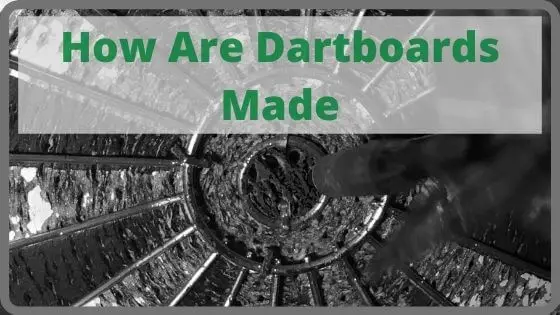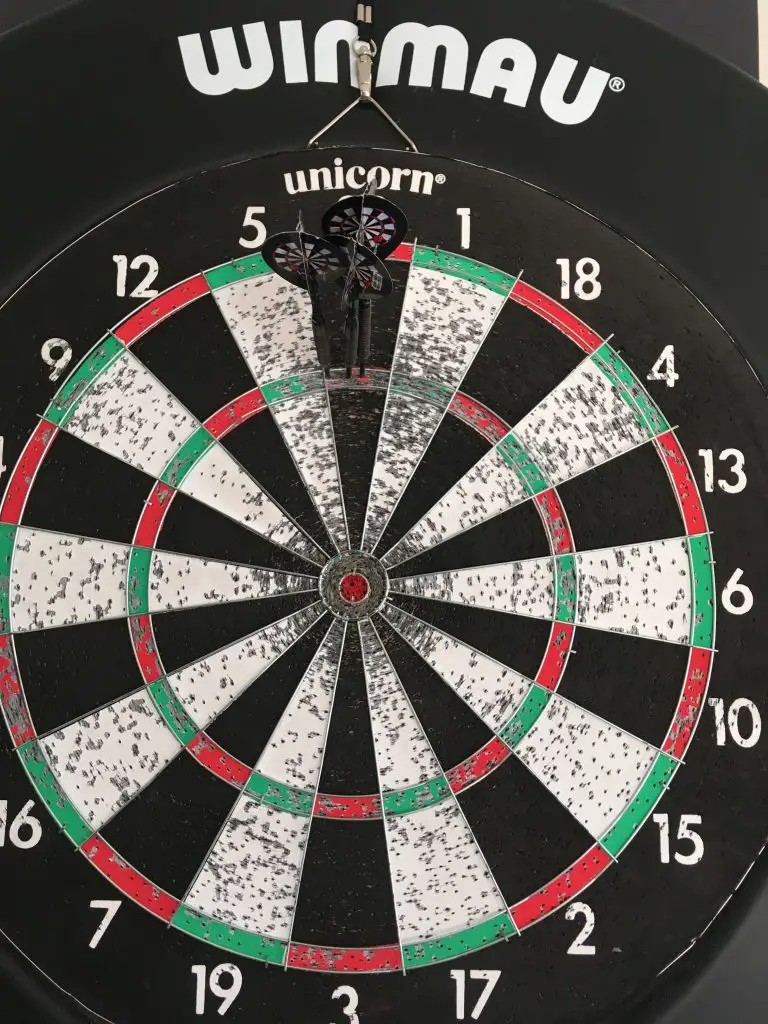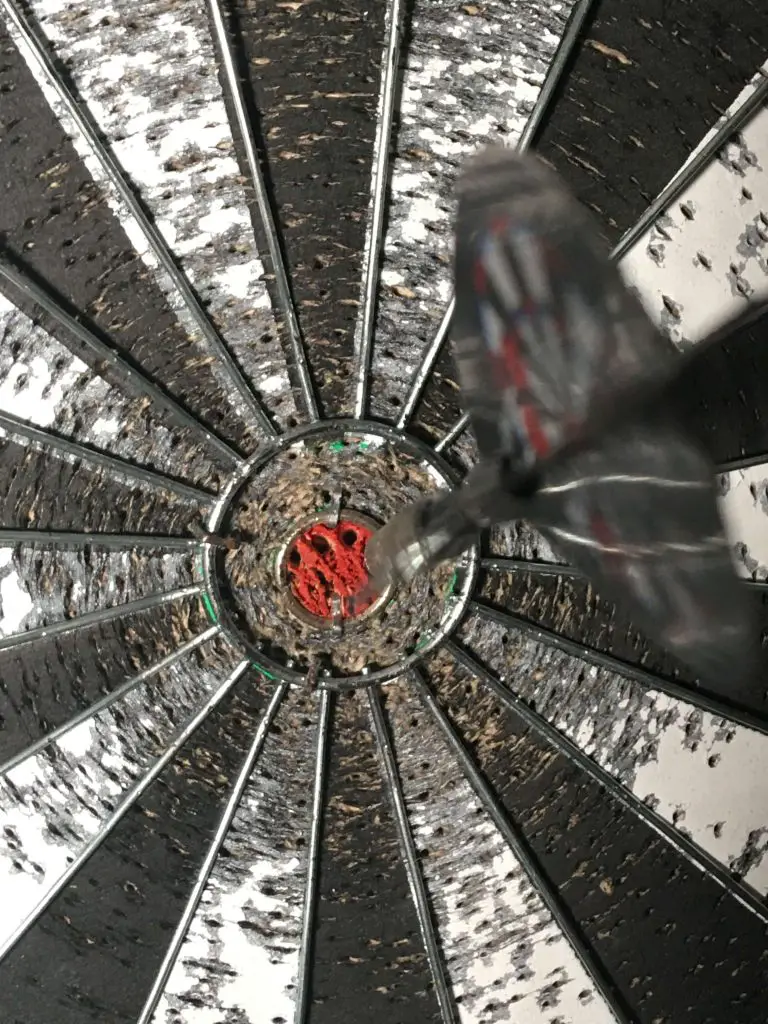The growing popularity of darts, incredible skill level displayed by some of the top pros, and the increasing prize money on offer in the game of darts has meant that investment in darts technology has been evident in recent years.
While darts gained initial popularity in the 1960s – 1970s, the manufacturing process for darts and dartboards has changed subtly over the years but these subtle changes have resulted in dartboards that last longer, maintain a better quality of play, require less maintenance, and result in fewer bounce-outs.
It sounds strange to say “darts technology” has improved, they are seemingly simple pieces of equipment for a casual pub-based game so, how are dartboards made?
Modern dartboards are made from sisal fibers. During the manufacturing process, these sisal fibers are compacted and pressed together to form the shape of the dartboard, they are then glued to the backing board, cut and sanded to size, painted, branded, and have the numbered ring attached.
In this article, I’ll be covering how dartboards are made, what are some of the different types of dartboard you can get (based on materials used), and some other interesting dartboard facts for those that are curious about the manufacturing process to produce these hard-wearing boards.
What Are Dartboards Made Of
Dartboards are an integral part of playing darts. Although it had undergone several changes in the past, one thing that stuck around is its material properties. Instead of getting deflected, incoming darts will stick to the board’s surface until removed.
In the modern setup, the mentioned dartboard property is done by using sisal fiber. But before using these fibers, people used various materials.
Common Materials Used In Dartboards
When it comes to competitions and tournaments, dartboards with sisal fiber are the de facto choice. But that doesn’t mean that it is the only option as a dartboard material. Here are some of the materials used for low-cost or DIY dartboards that you can use.
- Cork – this material is often found on low-quality, cheap, and lightweight dartboards. It is a good alternative if you’re a beginner and just trying to understand the game rules.
- Paper – for a one-time game with friends, a paper dartboard would be sufficient. Dartboards made with paper are usually designed for single-use and might only be good for recreational matches. Through regular practice though, a $10 paper dartboard only lasted me for around a month before it became unusable (images below). (((((((()))))))
- Wood – are used to create earlier dartboards (specifically, the elm board types.) Although durable and can last for a long time, the maintenance for this type of wood is costly. It needs to get moisturized regularly.
- Plastic – best for a safer family playing experience. Plastic dartboards are only usable on darts with soft plastic tips (the one with suction ends.)
Today, most tournaments use dartboards that use sisal fiber as the primary material.
Why Sisal Fiber
Sisal fibers are plant products that are extracted from the sisal plant. These plants are native to Southern Mexico and are usually gathered for rope making. You can see this fiber on different clothing products, but its usage is more prevalent in making dartboards.
One of the main reasons why sisal fiber is prevalent for dartboard manufacturing is its durability. The “buns” are durable enough to withstand the piercing of the dart tip. Even after getting pierced, sisal fiber boards tend to expand or go back to their former shape to seal up any damages from playing.
Are Dartboards Made From Horsehair?
There is quite a popular myth circulating in most dart communities: dartboard manufacturers use animal hair. In most statements, this particular animal hair used is horsehair. But contrary to this belief, horsehair is not used for dartboard making. Horsehair is one of the worst materials for competitive dartboards.
One of the reasons why sisal fibers are well-known for making boards is their stiff strands. These strands can support the dart in place while going back to its former shape earlier on. Horsehair fibers aren’t stiff and durable enough, which makes them incompatible with any dartboard manufacturing process.
Darts 101 – How Are Dartboards Made
Making a sisal fiber dartboard needs quite a bit of preparation. The manufacturers need a working facility where they can compact sisal fibers into circular forms. After that, they will need to paint it with appropriate colors. It should also have the right frames and wires installed in the body.
1. Sisal Fiber Gathering And Extraction
In most cases, manufacturers have their suppliers for sisal fibers. Before using any machine or device, sisal fibers would need to be cleaned and weave into long threads of loosely packed sisal threads. And that might need a lot of work, time, and resources.
2. Mechanically Packing Of Sisal Fibers
By pressing the threads together, the manufacturers are able to make a denser, more compact form of sisal fiber. This compressed sisal fiber is then processed into a circular mold to give its initial shape. Most manufacturers use an 18-inch mold to follow dart standards.
When the thread is compressed and molded enough, the tape is wrapped around it. The tape keeps the sisal fiber into shape, which helps in cutting it into “buns” or its circular form.
Dartboard manufacturers need to adhere to a certain density level to optimally prevent bounce-outs. Hence, they will need to press the buns into a more compact form, until the preferred density is achieved. It will then get sanded automatically for a smoother surface.
3. Paints And Metallic Wiring Layers
All the initial markings are screen printed to the sisal fiber. Machines take care of the alignment to make sure that the colors and markings are printed in the right place. Each color is hand-printed manually and is usually done by layers. The ink used in dartboards is designed to be visible even in low light while retaining durability for long-term use.
Once all the prints are embedded via screen printing, the wirings are glued and pressed into the board’s surface. These wirings help in separating the different score sections of the board.
4. Quality Control
The board is checked and tested for paint defects or faulty wiring plate installation. If no problem is detected, the outer edge ring is embedded (usually made with recycled plastic).
The outer edge ring will protect the sisal fiber and keep it in its circular shape. Lastly, the manufacturer adds the number ring and the branding. It is packaged sufficiently before release.
Should You Leave Your Darts In The Dartboard
Leaving a dart in the board for a short period of time is okay. It doesn’t affect the sisal fiber that much, because it goes back to its initial form immediately. However, sticking a dart for a long period of time can cause deformation and dryness within the sisal fiber.
Moisture can also permeate into the board, which will likely cause rotting or damage. Therefore, don’t leave your darts in the dartboard for a long period of time as this is a guaranteed way to cause irreparable damage to the sisal fibers and it’s something that can easily be avoided.
How To Take Care Of Your Dartboard
Sisal dartboards can last for a long period of time, but they will start to deteriorate eventually. If you play often, you might want to rotate your dartboard on a frequent basis to reduce wear and tear, especially for frequently used numbers like the 20 section, 19’s, and middle.
Avoid cleaning your board with liquid, and keep it dry as possible. Keep your darts sharpened adequately (not too sharp, and not too blunt.)
Final Thoughts
Historically, dartboards were made from wood and this meant the wires were embedded into the board itself and the board also required regular soaking in water for maintenance. I own a Manchester Log End board and can confirm that maintenance is unnecessarily time-consuming, especially when a wire pops out and you need to re-insert it.
The modern dartboard, made from sisal fiber and machine manufactured is not only more enjoyable to use (few bounce outs, better visibility, more rigid/slim frame) but it’s also much easier to maintain for long-lasting use.
As some dartboards start to incorporate smart technology, I’d say the way they are made is going to continue to change over the next 5-10 years but for now, the process is quite straightforward and it’s basically what I’ve laid out above.



